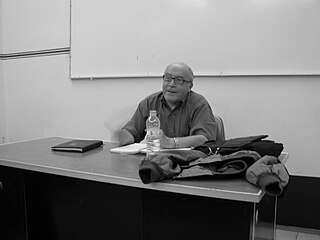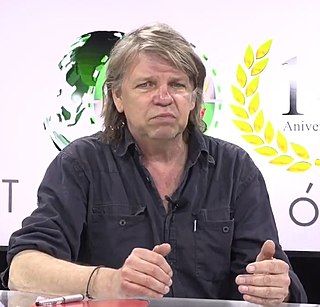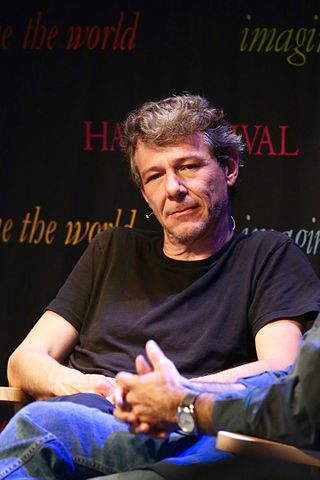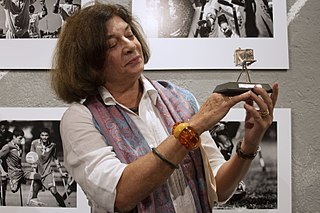Related Research Articles

Newsweek is an American weekly news magazine. It is co-owned by Dev Pragad, its president and CEO, and Johnathan Davis, who has no operational role; each owning 50%. Founded as a weekly print magazine in 1933, it was widely distributed during the 20th century, and had many notable editors-in-chief. The magazine was acquired by The Washington Post Company in 1961, and remained under its ownership until 2010.

Photojournalism is journalism that uses images to tell a news story. It usually only refers to still images, but can also refer to video used in broadcast journalism. Photojournalism is distinguished from other close branches of photography by having a rigid ethical framework which demands an honest but impartial approach that tells a story in strictly journalistic terms. Photojournalists contribute to the news media, and help communities connect with one other. They must be well-informed and knowledgeable, and are able to deliver news in a creative manner that is both informative and entertaining.

Sergio Ramírez Mercado is a Nicaraguan born and naturalized Colombian citizen, writer and intellectual who was a key figure in 1979 revolution, served in the leftist Government Junta of National Reconstruction and as vice president of the country 1985–1990 under the presidency of Daniel Ortega. He has been described as Nicaragua's "best-known living writer". Since the 1990s, he has been involved in the left-wing opposition to the Nicaraguan government, in particular in the Movimiento de Renovación Sandinista. He was exiled from the country in 2021 and stripped of his nationality by the government in 2023.
Chris Hondros was an American war photographer. Hondros was a finalist twice for a Pulitzer Prize for Breaking News Photography.
John Hoagland was an experienced American photojournalist and war correspondent for Newsweek from San Diego, California, who was covering the Salvadoran Civil War in El Salvador at the time he was killed. He had covered other conflicts, including those in Nicaragua and Lebanon.

Enrique Norten Rosenfeld, Hon. FAIA, is a Mexican architect and principal of the design firm TEN Arquitectos. Norten was born in Mexico City in 1954 where he graduated from the Universidad Iberoamericana with a degree in architecture in 1978. He obtained a Master of Architecture from Cornell University in 1980. In 1986, he founded TEN Arquitectos in Mexico City, initiating a lifelong commitment to architecture and design.

Pedro Friedeberg is a Mexican artist and designer known for his surrealist work filled with lines colors and ancient and religious symbols. His best known piece is the “Hand-Chair” a sculpture/chair designed for people to sit on the palm, using the fingers as back and arm rests. Friedeberg began studying as an architect but did not complete his studies as he began to draw designs against the conventional forms of the 1950s and even completely implausible ones such as houses with artichoke roofs. However, his work caught the attention of artist Mathias Goeritz who encouraged him to continue as an artist. Friedeberg became part of a group of surrealist artists in Mexico which included Leonora Carrington and Alice Rahon, who were irreverent, rejecting the social and political art which was dominant at the time. Friedeberg has had a lifelong reputation for being eccentric, and states that art is dead because nothing new is being produced.
Sergio Pitol Deméneghi was a Mexican writer, translator and diplomat. In 2005, he received the Cervantes Prize, the most prestigious literary award in the Spanish-speaking world.
Víctor González Torres, is a Mexican pharmaceutical businessman and politician, popularly known as Doctor Simi, the name of the character that represents his chain of companies, collectively called Farmacias Similares. In 2022 it became a trend to throw Doctor Simi plushies to singers in Mexico, and this was widely covered in social media.

Pablo Bartholomew is an Indian photojournalist and an independent photographer based in New Delhi, India. He is noted for his photography, as an educator running photography workshops, and as manager of MediaWeb, a software company specialising in photo database solutions and server-based digital archiving systems.

Renato Prada Oropeza was a Bolivian and Mexican scientist-literary researcher and writer, author of novels, short stories and poetry books, hermeneutics, semiotics and literary theory. Many of his literary works have been translated into several languages. He was one of the most distinguished semioticians in Mexico and Latin America.
Nacho López was an important figure in the photojournalism of Mexico in the 20th century. Unlike the current of the time, he mostly rejected the creation of images that made Mexico exotic and preferred the photographing of the common people of Mexico City over that of the country's political and social elite. He is credited for being the first in Mexico to work on photographic series, which he called “photo-essays” meant for publication in weekly pictorial magazines in the country. About half of his photographs were events staged by López designed to capture the reactions of bystanders. Although he was an active photojournalist for less than a decade in the 1950s, he was influential to the generations of photojournalists that followed him, with a collection of about 33,000 images now at the federal photograph archive in Pachuca, Hidalgo.

Teun Voeten is a Dutch photojournalist and cultural anthropologist specializing in war and conflicts. In 1996 he published the book Tunnelmensen about homeless people living in an old railroad tunnel in Manhattan. He also wrote books on the war in Sierra Leone and made a photo book on the drug violence in Mexico, on which subject he wrote a PhD thesis at Leiden University.

Álvaro Enrigue is a Mexican novelist, short-story writer, and essayist. Enrigue is the author of six novels, three books of short stories, and one book of essays.

Hector Garcia Cobo was a Mexican photographer and photojournalist who had a sixty-year career chronicling Mexico's social classes, Mexico City and various events of the 20th century, such as the 1968 student uprising. He was born poor but discovered photography in his teens and early 20s, deciding to study it seriously after his attempt to photograph the death of a coworker failed. He was sent to the Academia Mexicana de Artes y Ciencias Cinematográficas by magazine director Edmundo Valdés who recognized García's talent. Most of García's career was related to photojournalism, working with publications both inside and outside of Mexico. However, a substantial amount of his work had more artistic and critical qualities. Many of these were exhibited in galleries and museums, with sixty five individual exhibitions during his lifetime. This not only included portraits of artists and intellectuals but also portraits of common and poor people. He was also the first photojournalist to explicitly criticize Mexico's elite, either making fun of them or contrasting them to the very poor.
Renee Harari Masri is a Mexican designer.
Raúl Cervantes Andrade is a Mexican lawyer, academic, businessman and politician. He was CEO of CEA Abogados S.C., Vice-president of the National Chamber of Passage and Tourism Transportation and has been a Federal Deputy twice for PRI. He served as Senator of the LXII Legislature of the Mexican Congress from September 1, 2013 until August 30, 2014.
Pedro Pablo Preux was a Mexican tapestry maker of French origin, part of an effort to revive the craft as an art form in Europe under Jean Luçart then introducing and promoting the concept in Mexico in the 1960s and 1970s. Although tapestry making as art declined back to handcraft status starting in the 1980s, Preux’s efforts were recognized with membership in the Salón de la Plástica Mexicana and the Sistema Nacional de Creadores de Arte.

Sergio González Rodríguez was a Mexican journalist and writer who was best known for his works on the femicides in Ciudad Juárez from the 1990s to the 2000s, such as Huesos en el desierto and The Femicide Machine. González Rodríguez was a writer who worked in many literary genres, producing literary journalism or crónicas[es], novels, essays, and screenplays for documentaries. His writing was recognized with several awards in Mexico and Spain.

Christa Cowrie is a German-Mexican photographer, who began her career in photojournalism but is best known for her work documenting Mexico’s dance the theater events. Cowrie arrived in Mexico in 1963 and began her career in 1975 with the Excélsior newspaper. In 1977, she was one of the founders of the Unomásuno newspaper, also working to found one its supplements, focusing on ecological journalism. Her work began to shift towards photography dance and theater in the mid 1990s working with the Centro Nacional de las Artes. The archive she has created with this institution is one of the most important in Mexico documenting dance and theater. Her work has been recognized with membership in the Salón de la Plástica Mexicana.
References
- ↑ Nydia, Egremy (February 2006). "Sergio Dorantes, periodista prófugo espera justicia". Contralínea (in Spanish). Mexico City.
- ↑ Weiner, Tim (2001-06-15). "Mexico City Journal: Pummeling the Powerful, With Comedy as Cudgel". New York Times. ISSN 0362-4331.
- ↑ "Pedro Limon". Los Angeles Times. 2002-09-17. ISSN 0458-3035. Archived from the original on 2013-01-27.
- ↑ Zellner, Mike (February 2000). "Under the Hood". Latin Trade.
- ↑ Carlin, John (2005-12-04). "Culpable sin pruebas: una historia mexicana". El País (in Spanish). Madrid. Archived from the original on 2013-01-22.
- ↑ "Mexico: Will It Vote for Change?". BusinessWeek. 2000-07-03. ISSN 0007-7135. Archived from the original on August 15, 2000.
- ↑ "Murders put justice on trial in Mexico". Financial Times. London. 2007-04-19. ISSN 0307-1766. Archived from the original on 2011-07-11.
- ↑ Sergio Dorantes. "Crow Ceremony". Encarta. Microsoft Corporation. Archived from the original on 2009-04-17.
- ↑ Domínguez, Jorge I.; Alejandro Poiré (1999). Toward Mexico's Democratization: Parties, Campaigns, Elections, and Public Opinion. cover photo by Sergio Dorantes. New York City: Routledge. ISBN 978-0-415-92158-9.
- 1 2 AGZ (1999-08-16). "Sergio Dorantes, fotoperiodista mexicano expone su obra en la UIA". Nuestra Comunidad (in Spanish). Mexico City: Universidad Iberoamericana. p. 4.
- ↑ Hocine Benkheira, Mohammed (2001-08-16). "The Milk Family" (PDF). Slowfood. Italy: Slow Food Editore. p. 6. Archived from the original (PDF) on 2006-10-26.
- ↑ "Past Exhibitions". National Museum of Mexican Art. Archived from the original on 2008-09-24.